
views
X
Trustworthy Source
Mayo Clinic
Educational website from one of the world's leading hospitals
Go to source
Learn how to prevent accidental falls while saving yourself some pain and a bruised ego in the process.
Catching Yourself
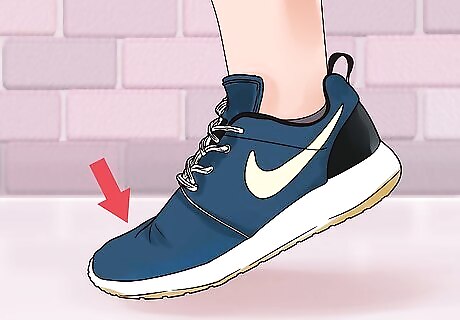
Plant your airborne foot. Unless you get knocked off your feet by a very strong force, you will likely still have one foot on the ground when you begin to fall. If possible, bring your airborne foot to the ground as quickly as possible. It is much easier to stabilize yourself on two feet than one. This might not be enough to save you from falling in situations where the ground is slippery (say, an icy sidewalk) or the ground is uneven or sloped. You are better off planting your foot a fair distance (12 inches or more) away from your other foot. A wider stance provides more stability. Plant your airborne foot in the direction you are falling. If your center of gravity is moving forward, but you plant your foot behind you, this won't improve your balance. This may not be possible in sideways falls where your airborne foot is on the opposite side as the direction of your fall.
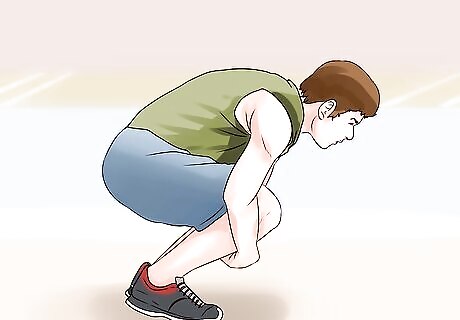
Squat down. Once you have two feet on the ground, bend at the knees and hips to lower your body toward the ground. This will lower your center of gravity, making it easier to stabilize yourself. This also uses your legs as shock absorbers to soften the impact to your joints of stumbling or falling. Make a conscious effort to bend at your waist and lean your torso opposite to the direction you are falling. This will further adjust your center of gravity and stabilize you. Just be sure not to overcompensate, as this could make you fall the other way. This step is most effective on flat ground, where you are most likely to be able to squat down quickly without hurting your knees. If you are a taller person, you may need to squat lower than someone who is shorter, as your center of gravity is naturally higher off the ground.
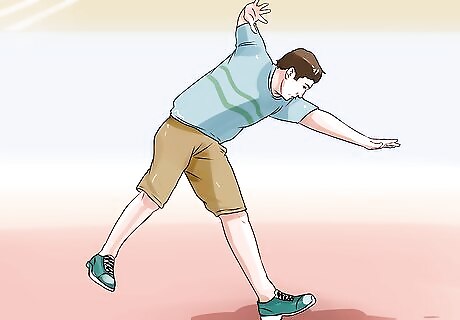
Use your arms to distribute your weight. Most people instinctively reach out when falling off balance to either grab a nearby object or counter-balance themselves against the direction of the fall. Sticking out your arms away from the direction your body is moving will help quickly offset your shifting center of mass. This way, you are fighting your body's tendency to let its mass be pulled down by gravity. Keep in mind that anything you might be holding onto when you lose your balance could end up going flying when you thrust out your arms. If possible, hold onto it for even greater counter-balancing potential. You'll need all the help you can get! This action is what gives falling people their signature flailing appearance, and you'll probably agree that it doesn't exactly look graceful. Nevertheless, it's better than the alternative.
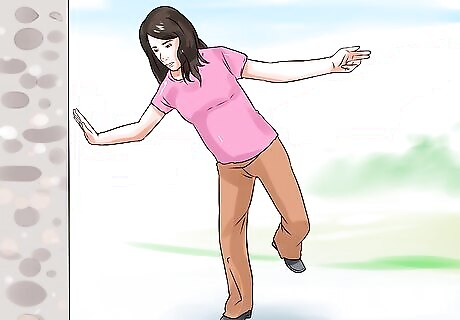
Grab onto something sturdy. As mentioned above, your natural tendency when falling will be to reach out and catch yourself on something. Go with this. If you can get a hand on something stable enough to support you while you regain your balance, you are much more likely not to fall. You will, however, have to be lucky enough to be within reach of something when you begin to fall. Walls, trees, railings, fences, parked cars, and even other people are good examples of things sturdy enough to catch yourself on. Just be aware that another person might go down with you instead. Some things may seem stable enough to hold onto but may tip over once pulled or pushed on with force. This is usually not something you have time to evaluate when falling, but it is worth being aware of. This is another action that could carry the consequence of accidentally throwing or crushing whatever you're holding at the time, as your natural reflex will cause you to rapidly extend your arm while opening your reaching hand.
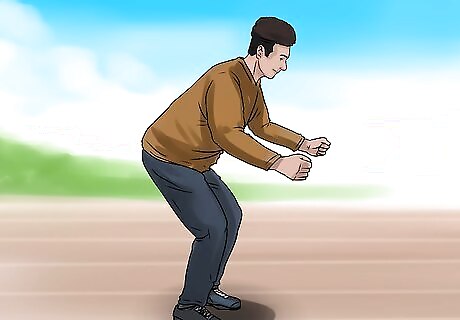
Adjust to uneven ground. Unfortunately, you will not always be standing on flat, smooth ground when losing your balance. If you are on stairs, boulders, or some other uneven surface when you begin to fall, you will need to adjust your balance-recovery strategy. Here are a few things to consider: Plant your feet on surfaces or objects that are as even with one another as possible. This will keep you from pulling yourself off balance even more while trying to plant your feet. If this is not possible, bend your knees and hips to counteract the different ground heights you're standing on. In some cases, it might be best to transfer your landing into a jog or run instead of a stationary position. This is likely to be a good option if you lose your balance while on unstable ground (like a rocky hillside) or when your body is already moving with some momentum. If you are slowly losing your balance, evaluate whether your landing will be more stable or safer by jumping as you fall. This way you can have a little extra time to reset your center of mass and land on two feet in a more or less vertical position. This is also useful in the event that you are near flat ground but not standing on it when you begin to fall.
Preventing Falls

Wear appropriate shoes. In some cases, being thrown off balance can be kept from turning into an actual fall by having on footwear suited to your activity. This is especially likely to prevent slips. If you are involved in an activity that puts you at greater risk of losing balance, chances are there is a shoe designed specifically for it that will improve your stability as much as possible. Obviously, not all falls occur during risky activities. You should not design your wardrobe or life around the relatively small chance that you could lose your balance at some point. Just be smart about your footwear when the situation calls for it. For example, don't wear sandals while walking on ice. Choose footwear that is not likely to actually cause a fall. Many loose-fitting shoes (including flip-flops and most other sandals) could cause you to lose your balance if they come off at an inopportune moment. Again, just don't wear loose shoes while playing sports or doing anything else that elevates your risk of falling.
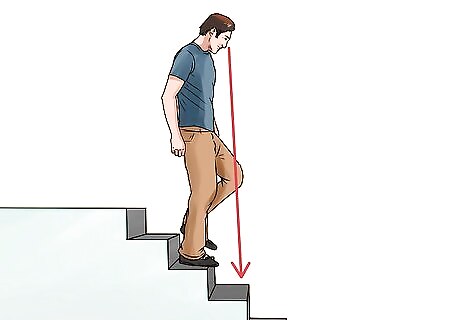
Look before you leap. A lot of falls occur when the person simply isn't looking where they're going. Minimize your risk by watching your step, especially in slippery or dimly-lit conditions. Being generally aware of your surroundings is good advice anyway, and will also help you more easily recover your balance if you do stumble. When walking or moving around at night, use a flashlight or headlamp (if the situation calls for it). Casting light on the ground in front of you will majorly decrease your likelihood of taking a spill. When walking down stairs, it is an especially good idea to look at the step in front of the one you're currently standing on. If you look at the spot where you intend to step, your brain will do a much better job of telling your foot where to go than if you just settle into a rhythm of bouncing down the steps.

Stay put when impaired. Sometimes people take medications or consume other substances that decrease their ability to maintain balance. If you are under the influence of alcohol or medications that cause instability and reduce reaction times, your best bet for reducing your chance of a fall is to minimize your movement, especially if you are by yourself. This doesn't mean you need to sit in a padded recliner if you have had a few drinks, but try to avoid walking long distances or participating in activities that involve lots of moving around on two feet. Use extra caution when walking down stairs. This can be particularly dangerous if you have impaired balance.
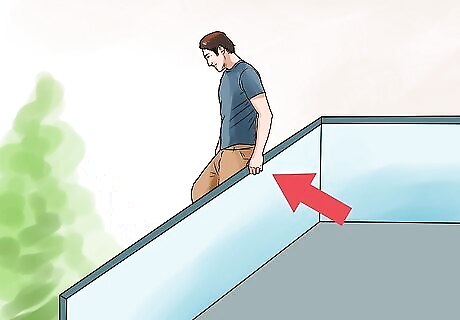
Use handrails. Almost all staircases and other inclined pathways (such as ramps) have handrails along their lengths, often bolted to a wall or other sturdy structure -- and for good reason. Hold onto these when moving down (or up) a steeply inclined path so you have an automatic safety net if you start to lose your balance. Gravity quickly takes over if you fall on stairs; don't let it win! Slide your hand along the railing as you move down the stairway instead of taking it off completely. This minimizes the likelihood that you could fall while repositioning your hand. Check that the railing feels secure. If your railing is not stable or well-attached, it won't do you much good if you use it to catch yourself. If it is not secure, use the one on the other side. If this is not an option, proceed cautiously.
Avoiding Injury When Falling
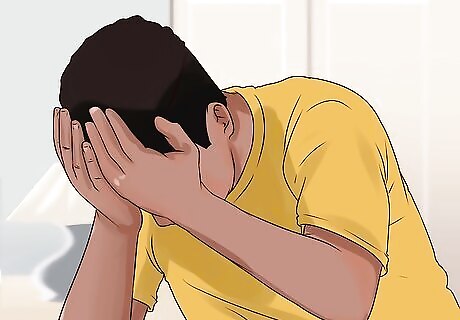
Protect your face. If you do fall all the way to the ground, protect your face and head above all else by covering them with your hands/arms. You should do this even if it means you could sustain an injury to another body part in the process. Head injuries can be very dangerous or fatal, so keep your head off the ground and away from any other hard, immobile objects. When falling forward, bring your hands in front of your face. This can serve the dual purpose of helping you catch yourself and protecting your face at the same time. When falling backward, put your hands behind your head and bend at the waist. This is the best way to keep your head off the ground and cushion the impact if you do make contact.
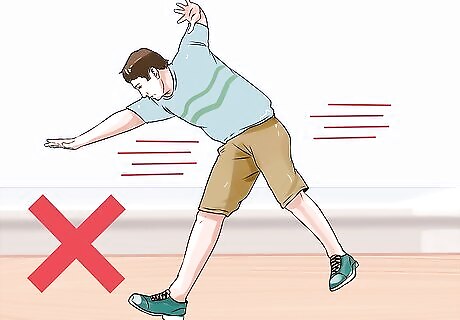
Consider your limits. In some cases, moving quickly to avoid falling could be almost as likely to cause injury as the fall itself. This is often the case for elderly people or those with pre-existing injuries. If you are likely to throw out your back by contorting to maintain your balance, there's a chance you're better off taking the fall and walking away with some minor scrapes and bruises instead. Much of your movement while losing balance is a reflex to the situation. As such, you might not be able to avoid a quick body adjustment, even if you are trying to avoid it. If you do have to allow yourself to fall to avoid a potentially more serious injury, try to land in a way that avoids sensitive areas or older injuries. For example, if you have a torn knee ligament that isn't quite healed, you might not want to plant that foot and should avoid hitting the ground with that knee by turning your injured body part away from the ground as you fall.

Use your arms as shock absorbers. If you fall forward to the ground, allow your arms to compress somewhat once your hands or forearms make contact. Think of this as doing a reverse push-up, where you are applying resistance to your arms but allowing them to flex to absorb the impact. This can help prevent arm bone fractures and will generally soften your landing. Any time you catch yourself with your hands or arms during a fall, there is a chance you could break a bone in your arm, hand, or wrist. While this is a risk nobody wants to take, it very well could be your best option to avoid more serious injury. Your risk of breaking a bone is higher if you brace your fall at an awkward angle, such as behind you while falling backward. This is because your arms are not suited to hard impacts while extended behind you, and your joints don't easily bend while in that position. The stronger you are in your upper body, the more effective this technique will be in helping you keep from being hurt in a fall.
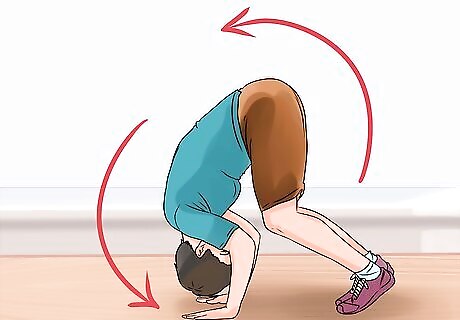
Roll with it. If you fall to the ground with some momentum (such as if you trip while running or fall off a tall object), you might be able to minimize your risk of injury by letting yourself roll on the ground instead of trying to come to a sudden stop. If you try to do this, just make sure you are protecting your head and neck. Contact the ground with your hands first, then your upper back/shoulder blade area. Try not to roll past your feet, as this could cause you to land on your face and defeat the purpose of rolling with your fall! When rolling forward (or end over end), arch your back and duck your head while bending at the waist. The more you can make yourself into a ball shape, the more easily you'll roll. When rolling onto your side (or barrel-rolling), keep your arms flexed and tucked in, with your hands over your face and your head ducked slightly forward. This will protect your face while keeping the back of your head off the ground.
Exercising to Improve Stability
Improve your single leg stance. To do this, start by standing with your feet together, and look forward. If you can do that, close your eyes and hold it for 30 seconds. If you fall over or lose your balance, keep practicing until you can hold that position for 30 seconds. To avoid falling if you lose your balance, practice this exercise in a corner of a room so your back is against 2 walls. Once you can hold your stance for 30 seconds with your eyes closed, move to a tandem stance. To do that, put one foot in front of the other, heel to toe—but it's okay if they're spaced out a little wider. Make this harder by closing your eyes, as well.
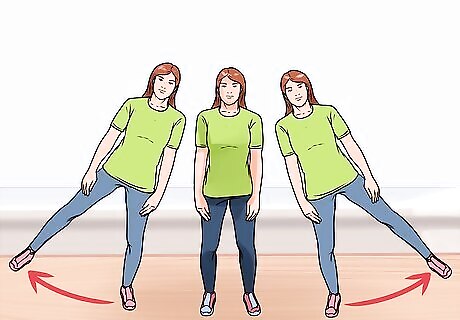
Practice weight shifts. To do this, stand with your feet hip-width apart and slowly shift your weight from one side to the other, lifting your opposite foot off the ground and holding the position for as long as possible (up to 30 seconds) before switching to the other leg. Repeat this exercise as many times as you feel comfortable. Stand near a stable object or wall if needed so you can grab onto it for stability if you start to fall. Increase your repetitions to boost the difficulty of this exercise as your balance improves. Choose a slightly unstable surface to stand on, such as a pillow or a BOSU ball for an even greater challenge.
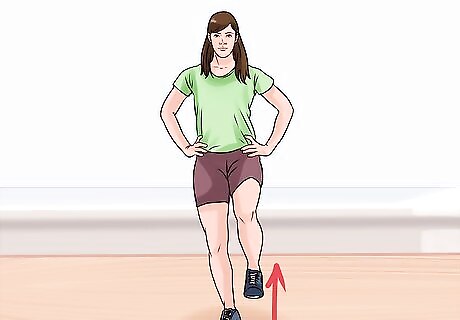
Do single-leg balancing. To begin this exercise, stand with your feet hip-width apart and your hands on your hips. While staying upright, raise one foot off the ground and bend your knee so your raised foot is behind you. Hold this position for up to 30 seconds, then switch to the other foot. Repeat this exercise until you've done each foot several times. For an added challenge, you can try reaching your airborne foot to the side or in front of you without touching it to the ground. This forces your balancing muscles to engage as you shift your center of gravity away from your body. Stand on an unstable surface or attach weights to your ankles to make this exercise more difficult.
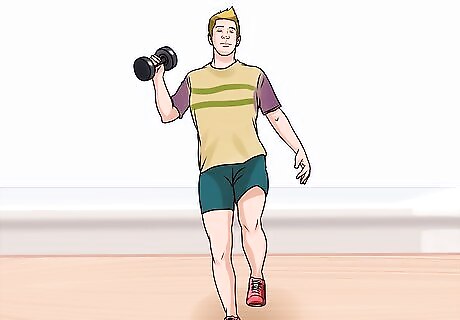
Do single-legged bicep curls. Begin this exercise by standing with your feet hip-width apart and grasping a dumbbell in one hand. Hold the dumbbell so that your elbow is bent at 90 degrees and your palm is facing upward. Lift one leg off the ground and hold that position for up to 30 seconds before repeating on the other side. Increase the difficulty of this exercise by gradually increasing the weight of the dumbbell. You can also try doing full bicep curls instead of keeping your elbow bent at 90 degrees. This will cause your muscles to constantly correct for the shifting weight. Try variations to this exercise, such as changing which leg you raise off the ground. It will be harder to lift the leg on the same side as the dumbbell, so work up to this if you can't do it when you first start exercising.
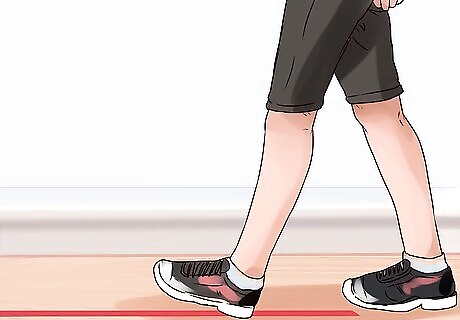
Walk straight lines heel-to-toe. You can work on improving your balance and test how far you've come by practicing walking in a straight line while placing one foot directly in front of the other with the heel of your front foot almost touching the toes of your back foot. Raise your arms to the side and hold them at shoulder height. Keep your eyes focused on a point far in front of you for added stability. Looking at your feet will make it harder to balance. Increase the difficulty of this exercise by moving very slowly or pausing with one foot in the air during each step. Turn around at some point along the line you've walked without breaking your posture and go back the other way.


















Comments
0 comment